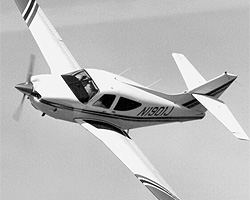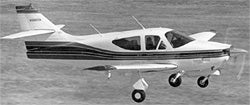 Rockwell Commander 112 | STANDARD DATA: (112) Seats 4. Gross wt. 2,800. Empty wt. 1,173. Fuel capacity 48-68. Engine 200- hp Lycoming. PERFORMANCE: Top mph 173. Cruise mph 163. Stall mph 62. Initial climb rate 1,020. Range 592-880. Ceiling 13,900. Takeoff distance (50') 1,585. Landing distance (50') 1,310. STANDARD DATA: (112TC) Seats 4. Gross wt. 2,950. Empty wt. 1,834. Fuel capacity 48-68. Engine 210-hp turbocharged Lycoming. STANDARD DATA: (Alpine) Seats 4. Gross wt. 2,950. Empty wt. 2,035. Fuel capacity 48-68. Engine 210-hp turbocharged Lycoming. |
 Rockwell Alpine Commander | |
 Rockwell Gran Turismo Commander | |
| STANDARD DATA: (Gran Turismo) Seats 4. Gross wt. 3,272. Empty wt. 2,070. Fuel capacity 68. Engine 260-hp Lycoming. PERFORMANCE: Top mph 191. Cruise mph 181. Stall mph 62. Initial climb rate 1,030. Ceiling 16,500. Range 722. Takeoff distance (50') 2,150. Landing distance (50') 1,200. |
The first deliveries of the Model 112 began in the summer of 1972 under the name of Aero Commander. A product of extensive consumer research, it was a fourseat, retractable gear aircraft, originally powered by a 180-hp Lycoming engine. A fixed-gear version of this low-priced Aero Commander was called the Model 111, but its production life span was short. The Model 112 features the most spacious cabin of any four-seat, single engine production aircraft, and for convenience it has a passenger access door on each side. Many new construction procedures were developed to facilitate assembly and reduce drag while retaining the plane's structural integrity.
The new manufacturing process included the use of large single assemblies rather than small pieces riveted together. The reduced number of rivets together with beaded skins improved airflow over the 112's surfaces. Subsequent additions to the line include the 112TC and the 114. The TC designation of the former means turbocharged, and the added boost helps the 112TC climb to 10,000 feet in 10 minutes. Even at 14,000 feet, the airplane can continue to climb at a rate of 900 fpm. The Model 114 utilizes a 260-hp normally-aspirated engine to provide a useful load with enough allowance for four persons, full fuel, a full radio package, and 100 pounds of baggage.
One change in the single-engine lineup was an emphasis on reduced drag by the elimination of certain scoops and the addition of several fairings. The result is a slight increase in speed for the 114, 112TC, and the 112B. The 112B also received new disc brakes and larger wheels. Both the 112 models were increased by over 100 pounds.
The 200-hp Rockwell 112 was dropped from the lineup of single-engine aircraft in 1979, and the names of the 112TC and the 114 were changed to the Alpine Commander and Gran Turismo Commander, respectively. These aircraft display slightly differing specification and performance figures, as reflected in the introductory summaries. The Gran Turismo is a three blade 260-hp model, and the Alpine is a 210-hp turbocharged wide-body Commander. They were offered fully IFR-equipped by Rockwell with King avionics and a Century III autopilot. The McCauley three-blade prop improves sound and vibration levels.
Rockwell discontinued production of the single engine line by 1980. In 1988, the fights for the Commander 112/114 were bought by a new company called Commander Aircraft, which allowed that company to maintain the existing fleet. Certification for a newly redesigned 114B was granted in 1991 and full production began once more with the 1992 model year.

Subscribe to Our Newsletter
Get the latest Plane & Pilot Magazine stories delivered directly to your inbox





